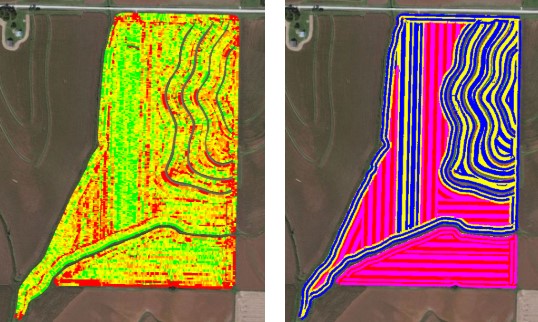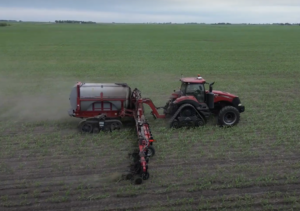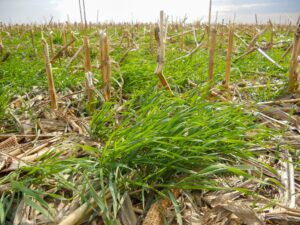By: 4R Plus
January 2020
Pottawattamie County farmer Adam Gittins uses precision ag tools to farm more efficiently. This is important to him since he works full time as the general manager for HTS Ag. The data he gathers on his farm has led to soil health improvements that have long-term financial benefits.
Mother Nature taught him the first year he farmed about the dangers of soil erosion on his sloping ground. “We had enough rains throughout the year that it eroded a very deep ditch that wasn’t apparent from the surface,” Gittins said. “We drove over it with the combine. The front axle went through it, but the back axle was literally swallowed by the ditch.”
That got him thinking about how to improve and protect the soil. He quickly added 12,000 feet of terraces to that quarter section of ground. Now, on all the land he farms, he no-tills corn following soybeans and uses a vertical tillage tool to lay cornstalks flat, while doing very little to disturb the soil. In the fall he modifies the vertical tillage tool to seed cover crops.
Gittins leans on precision ag tools and grid soil sampling to farm more efficiently, target acres with conservation practices and determine a prescribed 4R nutrient plan. “Precision ag provides my operation with huge time savings. At the same time, I’m collecting valuable data that I analyze to do a better job on the acres I have,” he said.

Data tells a story. “The more layers of data you have, the more complete story you have to improve for the next year,” Gittins said. “Every single pass across the field is cloud connected and the data is transferred in real time. The combine has a monitor and the grain cart has a monitor. All the data is transferred to the cloud and available at any time.”
Analyzing data allows him to target 4R Plus practices on acres that aren’t as productive. “I can’t afford to keep pouring inputs into the acres that pull productivity down,” he said. “We do a multiyear analysis and I can target my really low-producing areas to create a variable-rate planting and nutrient prescription.”
Data also helps him determine where cover crops would be most beneficial. “Where I see erosion starting or want to improve soil health based on data, I can target smaller areas and seed the cover crop,” he said. “Covers do a tremendous job of holding back erosion. I spent a lot of time doing tillage through the years, and where I’ve added cover crops, those areas are completely healed.”
For farmers hesitant to make the investment in precision ag technology, Gittins says applications for planters have the quickest return on investment, while harvest data provides the report card to understand how you did and how you can improve.
“I encourage farmers to take the first step in precision technology because it’s here to stay,” he said. “It’s a tool that will help you be more competitive and can be used to protect the soil. It’s setting my farm up to leave it in better shape for the next generation.”



